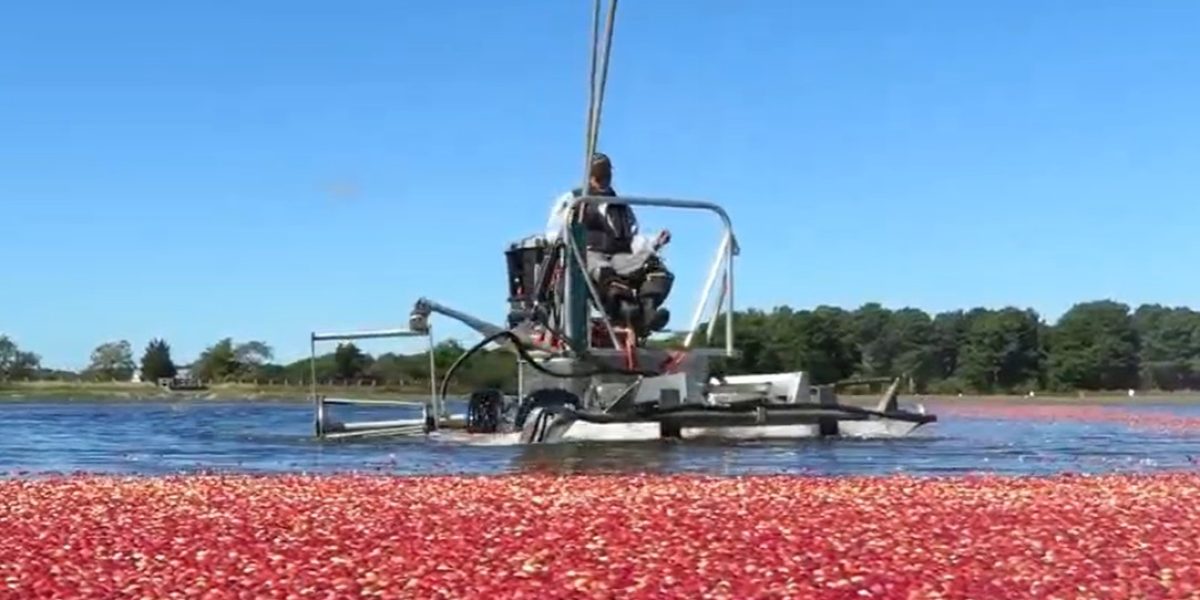CAPE COD TIMES – David Ross was on his bulldozer Tuesday morning in East Sandwich preparing one of his cranberry bogs for replanting. Ross has been harvesting the Cape’s iconic fruit for more than 40 years. This year he’s replanting two acres with high-yield cranberries.

One is a hybrid developed by researchers at the The Philip E. Marucci Center for Blueberry and Cranberry Research and Extension, a substation of the New Jersey Agricultural Experiment Station of Rutgers University.
Six patented cranberry varieties with increased productivity and quality have been developed at the research center. As of 2018, more than 5,000 acres worldwide of Rutgers varieties have been planted, according to the website. The varieties are being planted and grown in all U.S. cranberry growing states, Canadian provinces, Chile and New Zealand.
The other hybrid Ross is planting was developed by an independent breeder in Wisconsin, the country’s cranberry powerhouse.
Old varieties of cranberries are being phased out
Ross is replanting two acres this year, following the replanting of three acres last year and two acres the year before. The old varieties are being phased out, he said. The owner of Cape Cod Cranberry Realty Trust has close to 75 acres of cranberry bogs that stretch from Chatham to Sandwich. He wants to join the state’s growers who saw production increase by nearly a third in 2022.
Massachusetts cranberry growers harvested 2.26 million barrels of nutrient-rich fruit in 2022, a value of $82.16 million, according to King Whetstone, acting state statistician of the U.S. Department of Agriculture’s National Agricultural Statistics Service, Northeast Regional Field Office. It represents a 31% increase in production over 2021, according to the USDA.

Nearly 95% of cranberries are used in processed foods. Five percent of the crop is used fresh and mostly seasonally around the holidays. The price per barrel (100 pounds) varies. Hilary Sandler, director of the University of Massachusetts Cranberry Station said they sell their cranberry crop to Ocean Spray.
Cranberries from the Wilson Cranberry Farm Company in West Yarmouth were for sale at a stand near the bogs along Route 28, in October of 2022.
The company’s payments are related to sales, Sandler said. Ocean Spray might predict $42 a barrel based on quarterly earnings, but that price can go up or down based on market conditions. The past 10 years prices have been close to or below the cost of production, she said.
“In general, the prices are now above the cost of production,” she said in a phone call. “It’s been a challenge.”
Cranberry growers in Massachusetts saw increases from 2021 to 2022
The commonwealth’s cranberry growers saw increases in several categories from 2021 to 2022, including 100 more acres harvested, an increase in yield per acre, and increases in both total production and utilized production. The difference reflects what’s been harvested and what’s been rejected because of rot, substandard size and other factors.
While the price per barrel of cranberries dropped from 2021, the value of utilized production rose more than $18 million in 2022.
New Jersey State Statistician Bruce Eklund said the hot 2021 summer coupled with the drought didn’t hurt cranberries as much as other crops because cranberry growers are prepared to handle water needs with irrigation.
He attributed the increase in acres harvested to individual growers doing whatever it took to bring a bog back into production rather than an immediate response to market conditions or prices.
Eklund works for the USDA, “but in the background, getting good information.” The information lets farmers know how the crop is doing, how the crop performs over time, and how the state’s production compares to other regions of the country, particularly New Jersey, Oregon and Wisconsin.
How does Massachusetts compare to other states in growing cranberries?
Wisconsin ranks first, Massachusetts second and New Jersey and Oregon come in third and fourth in cranberry production. Wisconsin outshines all other states in cranberry harvesting. While Massachusetts cranberries brought in $82.16 million in 2022, Wisconsin’s crop of 4.84 million barrels was worth $186.6 million.
The sand and peat marshes used to grow cranberries in Wisconsin are perfect for the crop, according to the Wisconsin Cranberry Growers Association. Eklund said Wisconsin’s hotter temperatures relative to the Cape’s are another reason for the higher production figures. Growing degree days is a cumulative measure of how many days there are over a certain temperature that would stimulate growth: Wisconsin has more than Cape Cod and southeastern Massachusetts.
During the growing season it’s a lot warmer in Wisconsin than than by ocean, he said. “Wisconsin is a beast.”
Information about cranberry production, yield, and price per barrel helps people appreciate the contribution of agriculture in Massachusetts, Eklund said. Researchers use it to track yields over time, what’s causing declining yields, and to show the impact of agriculture on the U.S. economy. And researchers use the data to support grant applications.
“It shows people what agriculture’s contribution is, and that’s important,” Eklund said. “Ag policies are important. They’re tied to environmental policies and food security issues.”
By Denise Coffey



